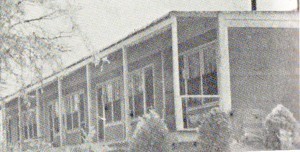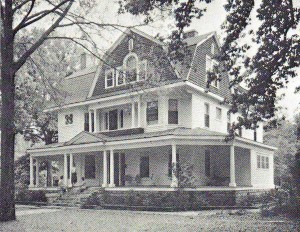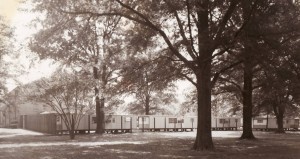Campus Housing at Presbyterian College – Part 2
October 2011
Our overview of campus housing at Presbyterian College began in the August 2011 edition of Blue Notes, covering the first few decades of the college’s history; this month we’ll continue from then until the present. Our thanks to archives assistant Sarah Leckie for this month’s blog.
In the early 1900s, as the student body of Presbyterian College continued to grow steadily, more dormitories were added to the campus: Laurens Hall (1907), Spencer Hall (1912), and Smyth Hall (1924). In the 1930s, the Great Depression brought new building to a halt. Then World War II erupted, bringing with it many changes to PC as the college adapted its schedule and facilities to assist in the war effort. In addition to an accelerated program for regular PC students which allowed them to graduate in 26 months, the college also housed a pre-flight training program under the authority of the War Department for pilots, navigators, and bombardiers. During this time, the college’s dining hall changed from seated family-style meals to the cafeteria system.

Vetville c. 1946
from Hammet’s The Spirit of PC
The end of the war led to increasing enrollment, with the size of the student body growing from 134 for the August-October 1945 quarter to 416 for the fall 1946 semester. Of those 416 students, 256 were military veterans, many of whom were married with children. The suites of Spencer Hall were able to accommodate the families of the first wave of veterans (in fact a few of those couples later introduced their children as having been born in Spencer Hall), but as enrollment continued to increase, it became clear that other housing options were needed. Thus in 1946 “Vetville opened in its wooden arms to married students. This facility consisted of three prefabricated, war-surplus buildings divided into 18 family-unit apartments” (Spirit of PC, p. 95). Expected to last about 10 years, Vetville remained part of campus for almost twice that long, until it was torn down in 1964 to make way for Richardson Hall.

Calvert House
from Hammet’s The Spirit of PC
The next big changes in campus housing began to take shape when in 1955 the Synod of South Carolina requested that PC consider constructing a women’s dorm in the near future. From the late 1950s to the early 1960s, a small number of female students were housed in Calvert House, a former private residence now owned by the college. Since a faculty family resided on the first floor of the building in order to supervise the students, “Calvert Convent” became the students’ name for the facility. Then in 1965 Clinton Hall, PC’s first women’s dorm, opened, marking PC’s move to full co-education.
Another men’s dormitory, Georgia Hall, was opened in 1968. However, by 1971 the waiting list of qualified female PC applicants led to pressure for additional space for women. Ten mobile home units were placed adjacent to Bailey Hall, which was built as a men’s dorm in 1955 but was now a women’s dorm. The administration called this facility Bailey Court, but, since the entire area was encircled by a ten-foot high wooden fence, students soon took to calling it “Fort Apache” after a popular television series.

Bailey Court c. 1971
In 1973, construction of a long-awaited fraternity court began. The six houses, rented from the college by the fraternities, formed a horseshoe on seven acres and each house provided accommodations for up to six students. They also gave the fraternities space for their meetings, not to mention their extremely popular social gatherings.
As the student body continued to grow, new dormitories appeared on campus. Mary Irwin Belk Hall opened in 1975 and the Grotnes-Barron Dorm Complex was completed in 1988. Housing options for PC students expanded further in 1997 with the construction of the Townhouses, which offer apartment-style living to seniors. Carol International House, a facility designed to provide a cross-cultural experience to both American and international students, was occupied in the fall of 2000. Senior Hall was added to the campus in 2002. These newest housing options provide students with amenities (such as cable television, internet access, and private bathrooms) that could hardly have been imagined by PC’s first students, who boarded with Professor Lee in his home according to the “college family” model. Hopefully they would have been proud and happy to see what PC offers to students today.
